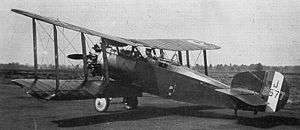Westland Weasel
| Weasel | |
|---|---|
 | |
| Role | Fighter |
| National origin | United Kingdom |
| Manufacturer | Westland Aircraft |
| First flight | November 1918 |
| Retired | 1925 |
| Status | Prototype |
| Number built | 4 |
|
| |
The Westland Weasel was a prototype British two-seat fighter/reconnaissance aircraft of the First World War. Designed to replace the Bristol Fighter, the Weasel was a single engined tractor biplane. Four prototypes were built, but no production followed owing to the failure of its original engine, although the prototypes were used as engine test beds for the successful Armstrong Siddeley Jaguar and Bristol Jupiter engines.
Development and design
The Westland Weasel was designed by Westland Aircraft of Yeovil to meet the Royal Air Force's Type IIIA Specification for a two-seat fighter/reconnaissance aircraft to replace the successful Bristol Fighter. An order for three prototypes was placed in April 1918, together with orders for competing designs from Bristol (the Badger and Austin Motors (the Greyhound).[1] The Weasel was a two-bay biplane of wood and fabric construction, with the pilot and observer/gunner seated close together in separate cockpits, with the upper wing above the pilot being cut away to improve the upwards view. Armament was similar to the Bristol Fighter, with two synchronised Vickers guns and one or two Lewis guns for the observer.[2][3] Like the other two competitors, the Weasel was powered by the officially encouraged ABC Dragonfly 9-cylinder air-cooled radial engine.[1]
The first prototype, although largely complete by the end of June,[4] had to wait for delivery of an engine, and did not fly until late November 1918, after the Armistice ended World War I.[5] As with the many other British aircraft projects of 1918, use of the Dragonfly engine proved a disaster, with the engine not only being underpowered and overweight, but more seriously, plagued with rapid overheating and severe vibration.[1] These problems were unsolvable, and although the Weasel had slightly better performance than the Bristol and Austin designs, the failure of the Dragonfly and the lack of urgent need to replace the excellent Bristol Fighter meant that large scale orders did not follow.[4]
Despite this, an order was placed for a fourth prototype to serve as an engine testbed. The first and third prototypes were fitted with the Armstrong Siddeley Jaguar radial, while the second and fourth aircraft were fitted with the Bristol Jupiter engine.[6] These aircraft proved valuable testbeds, with the last Weasel remaining in use until May 1925.[7]
Specifications (Dragonfly engine)
Data from War Planes of the First World War: Volume Three [7]
General characteristics
- Crew: Two
- Length: 24 ft 10 in (7.57 m)
- Wingspan: 35 ft 6 in (10.82 m)
- Height: 10 ft 1 in (3.07 m)
- Wing area: 368 ft² (34.2 m²)
- Empty weight: 1,867 lb (849 kg)
- Loaded weight: 3,071 lb (1,396 kg)
- Powerplant: 1 × ABC Dragonfly I 9-cylinder radial engine, 320 hp (239 kW)
Performance
- Maximum speed: 130.5 mph (113 knots, 210 km/h) at 6,500 ft (1,980 m)
- Service ceiling: 20,700 ft (6,310 m)
- Wing loading: 8.35 lb/ft² (40.8 kg/m²)
- Power/mass: 0.10 hp/lb (0.17 kW/kg)
- Climb to 15,000 ft (4,570 m): 19 min
Armament
- Guns: 2x forward firing, synchronised .303 in Vickers machine guns and 1 or 2× Lewis guns on Scarff ring in rear cockpit
See also
- Aircraft of comparable role, configuration and era
References
- Bruce, J.M. War Planes of the First World War: Volume Three Fighters. London:Macdonald, 1969. ISBN 0-356-01490-8.
- James, Derek N. Westland Aircraft since 1915. London:Putnam, 1991. ISBN 0-85177-847-X.
External links
| Wikimedia Commons has media related to Westland Weasel. |
- Aircraft Data Sheet: Weasel (1918). AgustaWestland.
| ||||||||||||||||||||||||||